Spatial Analysis ForIdentifying The Effect Of Diet On Mammals
Question
Task:
Assessment Task
Report your findings obtained through spatial analysis according to the general format expected in either a scientific paper, or management report, as suggested in the instructions provided for each of the data sets. As this is a methods unit, the style of writing should aim to follow that used in a paper or management report, however some more reflective text explaining your application and understanding of the methods can also be included.
Output Graphs
(The report should be made based on these three graphs given below. Analyse the graph and give a brief description based on this and answer the question addressed in the aim section)
1.
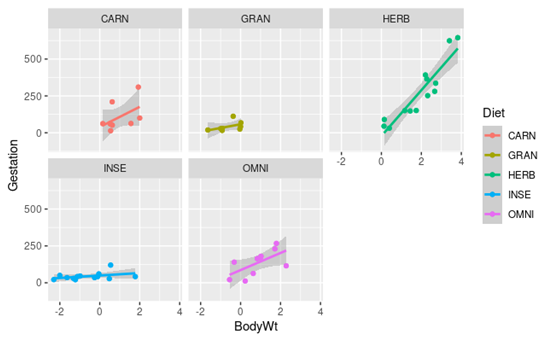
Figure 1: Scatter graphs depicting relationship between Gestation, BodyWt and Diet
(Note:I had done the anova test and found thatp-value: 1.836e-08)
2.
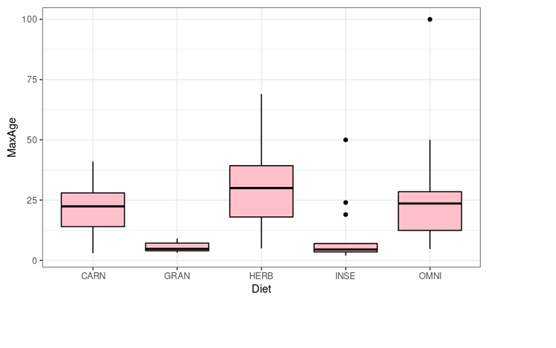
Figure 2: Boxplots depicting relationship between Diet and MaxAge
(Note: I had done the anova test and found that p-value: 0.005711)
3.
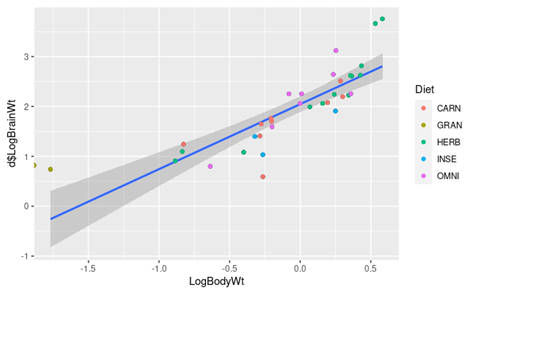
Figure 3: Scatter graph depicting relationship between BrainWt, BodyWt and Diet
(Note:I had done the anova test and found that p-value: 4.597e-06)
Answer
Introduction and aims of the analysis
The paper is a spatial analysis of the experiment conducted by the team for identifying the effect of diet on mammals. The primary objective of the research was to build a relationship between the Gestation period and Diet, Maximum Age and Diet, and Brain Weight, Body Weight, and Diet. The paper aims to clear the objectives through experiments conducted based on obtained data. The report contains the analysis of the relationship built between the requested quantities and outlines the effect of the diet on mammals.
Initially, the analytical methods used in the paper are clearly outlined and explained in detail, describing the tools and techniques used to obtain the data. Next, the result section in the report represents the result obtained through graphs and models. It explains the significance of the acquired data and its effect on mammals. Later, the discussion section outlines the outcomes and describes the role of diet in a living being.
Analytical Methods
The research contains the analysis of the data through three different techniques. The analysis methodology helps find the utmost outcome needed to satisfy the research outcomes.
The first objective is to identify whether food habits influence the gestation and bodyweight of mammals. It is resolved using the scattered graph that helps to calculate the variance in the data from an ideal path. The plotting of the values on the cartesian graph portrays the actual trend in the mammals having different diets. The relationship established through the scattered chart helps identify the variation in the data, whether it is positive, negative, or mixed. It answers essential questions like whether the gestational procedure increases with bodyweight or not (Nagy, 2018).
The second aim of the research is to identify the effect of dietary habits on the life span of mammals. Specifically, focus on identifying the relationship between these two quantities. For acknowledging the relationship, a Boxplot graph is used (Li, et al. 2022). A Boxplot graph provides a better overview of the value spread in the data. Though the data presented is primal, it consumes less space and provides a better overview while comparing in groups. The Boxplot graph used in the research finding outlined the maximum age group of mammals having different diets.(Bastos, Mecenas, and Normando, 2021) The third objective of the research is to obtain the impact of diet on the brain weight and bodyweight of the mammal. The best way to get reliable results from the data is through a Scattered graph. The chart used in this case is combined rather than split. In this, each dot represents a diet, and the gap from the central line indicates its variance. The comparison of values obtained through the graph got simpler as it was easier to compare from the ideal output. Also, the ANOVA test is performed on each chart to determine the impact of different factors on the value obtained.(Smaga, 2019)
Results
Relationship between Gestation, Bodyweight and Diet
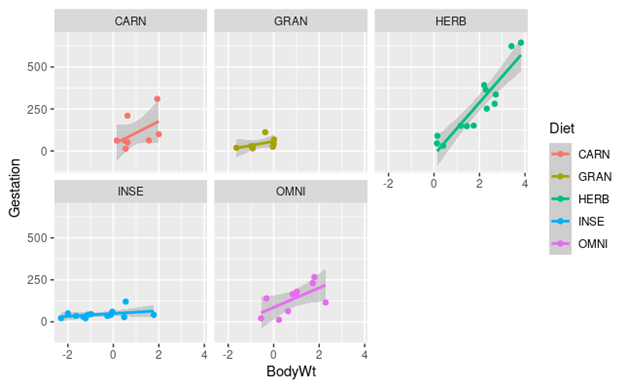
The comparison of Gestation with the Bodyweight was made separately for each diet group. Each diet has a specific color representation (Carn- Red, Gran- Yellow, Herb- Green, Inse- Blue, Omni- Pink). The Gestation by Bodyweight (Gestation/Bodyweight) value varied largely among diets. For Carn, the ratio ranged from 0 to 250. The rate is high due to immense differences between the Gestation and the Bodyweight of the animals having a Carn diet. The variance observed in this diet is highest among other diets. The second graph depicts the ratio of Gran's diet. The graph slope is not steep, as the values ranged from 0 to 100. The distribution shows that the difference is comparatively lesser than the previous one. The gradient of the Herb diet is the highest, as the values of Gestation over Bodyweight have increased the graph height. In the overall study, the herb diet had the maximum slope with a higher points range. For the Inse diet, the slope value comes to be very small. Although a few points had a higher shift from the mean path, the variance is observed least in this case. In the Omni diet, the variance was marked as the second highest. The values ranged from 0 to 250, but the noise in the data was high. After plotting and calculation, variance analysis (ANOVA test) was performed on the data obtained from which the value of p was obtained. In the given graph, the value of p was 1.836e-08.
Relationship between Diet and Max. Age
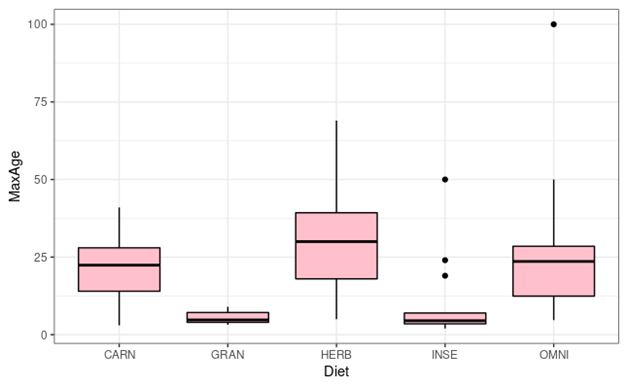
The Boxplot graph helped obtain a quicker and wider range of values from the given data. The Boxplot chart display values based on a five-number summary. The dots on either side of the box depicts the minimum and the maximum number in the range. For Carn, the maximum age value ranged from 13 to 27 years. The median value of the diet is approximately 23 years. The first quartile had higher value coverage over the third quartile with more percentile value. For Gran, the maximum age had a smaller range. The difference between the maximum and the minimum value was observed lesser compared to other diets. The mean value of the diet was almost eight years, and the third quartile had a higher percentile than the first quartile with more coverage. For Herb, the maximum value had a very high range. The data in the diet ranged from 5 years to 72 years. The median value obtained in this diet is almost 30 years. Also, the first and the third quartile had more coverage on the graph with a higher percentile ratio. For Inse, the exact minimum and maximum values are denoted using outliers. The age ranged in this diet from 2 to 10 years. The median value of the diet is four years. However, the first and third quartile ratio is less with a major percentile of the third quartile. For Omni, the age group falls majorly in the range of 13 to 27 years with a median value of 24 years. The first quartile percentile is over 70% compared to the third quartile. The value obtained after performing the ANOVA test on the obtained result, the p-value obtained is 0.005711.
Relationship between Brain weight, Bodyweight and Diet
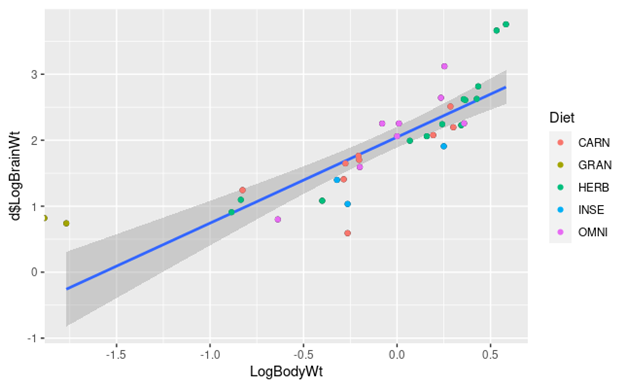
The effect of diet on brain weight and body weight was obtained by building a relationship among these quantities. The impact of diet was determined by plotting the brain weight and bodyweight of the mammals on a scattered graph. For detailed and better results, all the diets were represented on a single scattered chart, where different color dots got used to differentiate the diet. The majority of the values lay near the ideal line. However, the Gran depicts the highest variation in the graph where the weight was comparatively lesser than the body. For Carn, the distortion in the value varied from mammal to mammal. For the majority of mammals, the obtained data lay close to the ideal significance, but in a few cases, the variation was extensively high. For Herb, the variation depicted fell in every region. Few mammals showed an ideal brain by body weight ratio and satisfied all the results. Though, few had established an extensive upper and lower variation in their value with lengthier separation from the ideal path. Inse diet consumers mostly showed a fixed variance in the ratio, and each had almost similar results. For Omni diet mammals, the results were analogous to the Herb. However, the majority of the mammals had shown an ideal ratio for the weight, while few had variance with variable values. ANOVA test was performed on the obtained data, and the value of p obtained in this case was 4.597e-06.
Discussion
The primary conclusion drawn by conducting experiments and analyses is that "diet has a significant impact on an individual's body." From the graph obtained through the relationship between Gestation and Bodyweight, it is observed that the gestation period in a mammal varies chiefly with the diet. Mammals having Herb diet have a much-extended gestation period compared to others. The ANOVA test performed in this case has indicated that the variation is not significant (Doherty, et al. 2022).
In the graph obtained by building a relationship between maximum age and diet of the mammal, it is observed that the herb-consuming mammals have a longer life than others, followed by omnivorous and carnivorous mammals. A similar result is visible in the third case, where herbivores have higher superior value and less variance. The consumption of green plants and fruits keeps the body healthier and freer from toxins. It benefits the mammals consuming them in every means.(Stover, et, al. 2018)
Conclusion
A healthy and sufficient diet is necessary for every living being to sustain a better life. The diet plays a crucial role in life, and the report fulfills to highlight the importance. The usage of tools such as Scattered graphs and Boxplot graph simplifies the analysis procedure of the data through its simplified procedure and working. In every scenario, the herbivorous mammals have dominated over any other diet-consuming mammals. They have a longer gestation period, live extended life, and have a perfect body mass ratio. The calculation of p-value in ANOVA methodology helped to calculate the exact variation of the group from its significant value, making data more reliable and accurate.
References
Bastos, R.T.D.R.M., Mecenas, P. and Normando, D., 2021. Effects of dietary consistency on the occlusal changes in nonhuman mammals: A systematic review. Archives of Oral Biology, 130, p.105217. https://www.sciencedirect.com/science/article/pii/S0003996921001801
Stover, P.J., James, W.P.T., Krook, A. and Garza, C., 2018. Emerging concepts on the role of epigenetics in the relationships between nutrition and health. Journal of internal medicine, 284(1), pp.37-49. https://onlinelibrary.wiley.com/doi/abs/10.1111/joim.12768
Smaga, 2019. Repeated measures analysis for functional data using Box-type approximation—with applications. REVSTAT, 17(4), pp.523-549. https://www.ine.pt/revstat/pdf/REVSTAT_v17-n4-5.pdf
Doherty, S.P., Collins, M.J., Harris, A.J., Sistiaga, A., Newton, J. and Alexander, M.M., 2022. A modern baseline for the paired isotopic analysis of skin and bone in terrestrial mammals. Spatial analysis Royal Society Open Science, 9(1), p.211587.https://royalsocietypublishing.org/doi/full/10.1098/rsos.211587 Nagy, K., 2018. Food requirements of wild animals: Predictive equations for free-living mammals, reptiles, and birds.https://escholarship.org/uc/item/18s7d943
Li, F., Yang, S., Zhang, L., Qiao, L., Wang, L., He, S., Li, J., Yang, N., Yue, B. and Zhou, C., 2022. Comparative metagenomics analysis reveals how the diet shapes the gut microbiota in several small mammals. Ecology and Evolution, 12(1), p.e8470.https://onlinelibrary.wiley.com/doi/full/10.1002/ece3.8470












